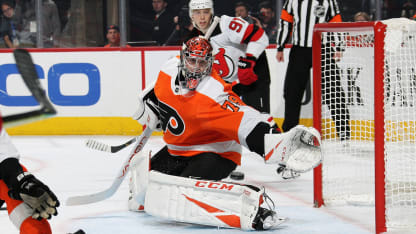VANCOUVER -- Carter Hart was one of the last cuts from Everett of the Western Hockey League when he was 15 years old, so imagine his surprise at being the first cut from his minor hockey team back home a few weeks later.
Hart working on mental skills to improve his play for Flyers
Goalie using concentration grids, juggling to maintain focus in games

© Len Redkoles/Getty Images
By
Kevin Woodley
NHL.com Independent Correspondent
Now imagine him still struggling to stop pucks two months after being dropped to that lower level. Those struggles prompted a visit to sports psychologist John Stevenson and a lesson in mental strength and focus that still serves Hart today with the Philadelphia Flyers.
"I came into Johnny's office, and I was probably in tears at the time, and I was so mad at the coach for not picking me and for cutting me from the midget AAA team," Hart said.
Stevenson asked Hart why he still was letting that coach determine the path of his hockey career. Why was he focused on something that happened two months earlier, allowing it to affect his play, his chances of getting back to the WHL and, ultimately, realize his dream of making the NHL?
"You should have seen his face," Stevenson said. "He was mad."
In that instance, a lesson on the importance of staying in the moment was cemented in Hart, one that helped him when he struggled in the American Hockey League last season. It continues to benefit Hart, whether he's dealing with questions about the Flyers' decades-long search for a franchise goalie or the inevitable ups and downs of playing his first full NHL season at age 21. But any suggestion that Hart's mental strength comes naturally ignores how hard he worked to develop it, using everything from juggling to concentration grids to cold showers.
"I mean, maybe that's just who I am, but I've worked with John since I was 10 years old and we worked on how I approach the game and my mental makeup," Hart said. "You can't control what other people think and their decisions. You just have to worry about the decisions you make and what you do to help yourself become a better person and a better goalie."
Stevenson, who also has worked with Braden Holtby of the Washington Capitals since Holtby was in the WHL, praised Hart for taking advantage of numerous tools to improve his mental game.
"When we talk about controlling the controllable, Carter's work ethic stands out," he said.
When an ankle injury kept Hart off the ice for two weeks late last season, he used the extra time to train his brain, studying game film with Flyers goaltending coach Kim Dillabaugh and re-engaging with the concentration grids he first used as a teenager to improve his focus.
Those grids, which Stevenson also has used during work with Holtby and Laurent Brossoit of the Winnipeg Jets, feature randomly scattered numbers that goalies must cross off in order from 1 to 100 on a 10-by-10 grid, or even higher for bigger grids. In addition to being able to focus, it helps develop good visual habits as goalies scan ahead for the next number.
Hart, who is 2-2-1 with a 2.59 goals-against average and .890 save percentage in five games this season, holds the 10-by-10 record among Stevenson's pupils at 1 minute, 45 seconds.
"It's helped me stay sharp," Hart said. "Sometimes I would do it in front of the TV when I was younger, put on my favorite show or a hockey game and do a concentration grid so that I keep trying to keep my focus on doing what's in front of me and not let my mind wander."
As Stevenson tells his young goalies, even the best lose focus during a game.
"It's about recognizing when our focus drifts and bringing it back," he said. "Becoming aware of quality of thinking so we can control it so our focus is on the right thing at the right time."
It's why Hart frequently sprays water into the air and tracks one drop as it falls to the ice during breaks in play or after a goal, a technique Holtby also uses to help refocus himself.
It all ties into Stevenson's mantra for his goalies: "I have no future. I have no past. My goal is to make the present last. I am right here, right now."
According to Stevenson, being able to focus on one shot at a time is a key to finding the zone that all goalies crave.
"That is a skill," he said.
It's a skill Hart has honed using numerous tools, including online visual training programs he can do on his iPad, and learning to juggle four, and hopefully soon five, balls. Stevenson said the work is designed not only to enhance Hart's visual skills but also multiobject tracking.
"Why five?" Stevenson said. "Because a goalie has to track five players on the ice. He's training his eyes and his brain to read the play at faster and faster rates."
Hart said that despite all this mental training during the past 11 years, he barely slept before his NHL debut Dec. 18 and struggled to sleep during his first two weeks in the NHL last season.
Like every other challenge, he found tools to deal with it, including cold showers.
"I started getting back into more body-scan techniques, meditation techniques," he said. "It was helping but it wasn't really helping me still get a great full night's sleep. Cold showers helped me to cool my body down before bed and get a good sleep."
Just like all those years ago, when he figured out worrying about being cut from midget AAA wasn't going to help him stop pucks for two months, Hart was able to get himself back in the moment. His ability to do so consistently is a big reason for where he is.

















